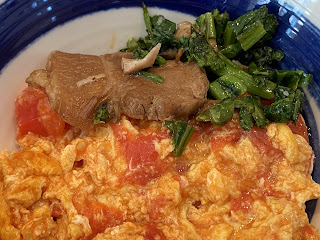We like
cauliflower puree. Now I changed how I make it and the process is easier but the results are the same (I added the directions below). We used
the puree for quite a few dishes. Recently, we revisited one of our favorite fish dishes; Chilean sea bass (Patagonian tooth fish). We really like this fish
over a bed of Cauliflower puree. Recently we tried a similar combination using seared diver scallops which we got from
Great-Alaska-Seafood. I made an impromptu pan sauce which went well.
For seared scallops
Ingredients (for two small servings)
4 diver scallops, thawed if frozen, patted dry and seasoned with salt and pepper
1tsp peanut or other vegetable oil
Pan sauce:
2tbs Japanese sake for deglazing
1tbs lemon juice
1 tsp x4 concentrated Japanese noodle sauce
1 tbs of cold butter
Directions:
Add the vegetable oil with high smoking point to a stainless steel or iron frying pan on medium high flame. Heat the pan until the oil just starts smoking
Add the scallops and brown one side for 1-2 minutes and flip-over . Brown the other side for another 1 minute or until the scallops are just cooked in the center (expect some smoke).
After removing the scallops, add the sake and deglaze the pan. Reduce the liquid to half. Add the noodle sauce and the lemon juice. Reduce briefly and finish with pats of butter.
Place the scallops on the bed of warm cauliflower puree and pour the pan sauce over the scallops.
For cauliflower puree
Ingredients (makes at least 4 to 6 servings):
One head of Cauliflower, washed and florets separated
1 to 3/4 cup 4% milk, warm (I microwave but be careful of over boiling)
Several thin pats (2-3 tbs) of cold butter
1/2 tsp salt or to taste
Directions:
Steam the florets for 7-10 minutes or until very soft.
Meanwhile warm the milk (I microwave but be careful of over-boiling)
In a cylindrical container for a immersion blender, add the cauliflower and half of the warm milk.
Press down the immersion blender at a medium speed, up and down several time.
Depending on the consistency add more milk and blend in high-speed until silky smooth (may take some time to attain the smooth puree).
Add the butter and salt and further blend
Taste and adjust the salt
We really like this combination. The pan sauce also worked well. If this is a main dish, I would use 4 scallops per serving and add side vegetables.


















